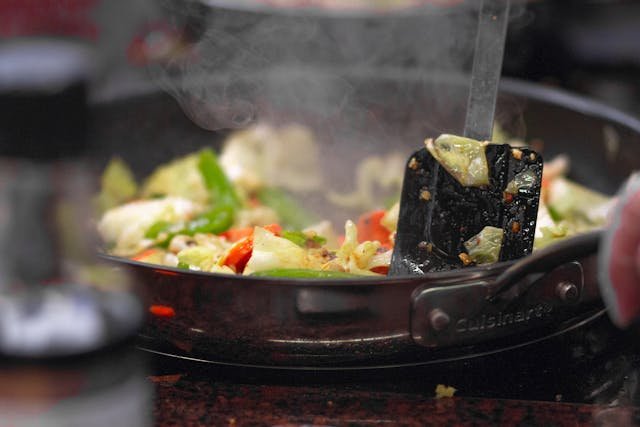Learning Chinese baking and cooking terms can be incredibly helpful, whether you’re a passionate home cook, a professional chef, or simply a food enthusiast. These terms will assist you in understanding recipes, following cooking shows, and communicating more effectively in the kitchen. Here is a comprehensive guide to common Chinese baking and cooking terms, complete with detailed explanations and examples.
Table of Contents
ToggleBasic Terms
Before diving into more specific terms, it’s important to know some basic words and expressions that are frequently used in Chinese recipes.
Basic Ingredients:
- Flour – 面粉 (miàn fěn)
- Flour is a staple ingredient used in a wide range of recipes, from dumplings to noodles. Common types include 小麦粉 (xiǎo mài fěn) for wheat flour and 玉米粉 (yù mǐ fěn) for corn flour.
- Sugar – 糖 (táng)
- Sugar adds sweetness to both savory and sweet dishes. Varieties include 白糖 (bái táng) for white sugar and 红糖 (hóng táng) for brown sugar.
- Oil – 油 (yóu)
- Oil is essential in Chinese cooking, used for frying, stir-frying, and more. Common types include 花生油 (huā shēng yóu) for peanut oil and 菜籽油 (cài zǐ yóu) for canola oil.
- Eggs – 鸡蛋 (jī dàn)
- Eggs are versatile and used in various ways, from scrambled eggs to binding ingredients in dumplings.
- Salt – 盐 (yán)
- Salt enhances the flavor of food. Common types include 海盐 (hǎi yán) for sea salt and 精盐 (jīng yán) for fine salt.
- Water – 水 (shuǐ)
- Water is a key ingredient in many recipes, from soups to doughs.
- Soy Sauce – 酱油 (jiàng yóu)
- Soy sauce is a fundamental seasoning in Chinese cuisine, available in light (生抽, shēng chōu) and dark (老抽, lǎo chōu) varieties.
- Vinegar – 醋 (cù)
- Vinegar is commonly used for its sour flavor. Types include 米醋 (mǐ cù) for rice vinegar and 香醋 (xiāng cù) for black vinegar.
- Ginger – 姜 (jiāng)
- Ginger is a staple in Chinese cooking, used fresh or in dried form.
- Garlic – 蒜 (suàn)
- Garlic adds a pungent flavor to many dishes and is used both raw and cooked.
Common Cooking Terms
Here are some essential cooking terms that will help you in the kitchen:
- Cook – 烹饪 (pēng rèn)
- Generally refers to the act of preparing food with heat.
- Boil – 煮 (zhǔ)
- Boiling involves cooking food in water or broth at a high temperature with rapid bubbles. For example, 煮饺子 (zhǔ jiǎo zi) means to boil dumplings.
- Simmer – 煨 (wēi) or 炖 (dùn)
- Simmering involves cooking food gently in liquid at a low temperature, ideal for soups and stews. 炖鸡汤 (dùn jī tāng) means to simmer chicken soup.
- Stir-fry – 炒 (chǎo)
- Stir-frying involves quickly frying small pieces of food in a hot pan with a small amount of oil. For example, 炒青菜 (chǎo qīng cài) means to stir-fry green vegetables.
- Deep-fry – 炸 (zhá)
- Deep-frying involves cooking food in hot oil until it is crispy. For instance, 炸春卷 (zhá chūn juǎn) means to deep-fry spring rolls.
- Steam – 蒸 (zhēng)
- Steaming involves cooking food with steam, often using a bamboo steamer or a metal steamer basket. For example, 蒸鱼 (zhēng yú) means to steam fish.
- Braise – 红烧 (hóng shāo)
- Braising involves cooking food slowly in a sauce. 红烧肉 (hóng shāo ròu) means to braise pork belly.
- Blanch – 焯 (chāo)
- Blanching involves briefly boiling food and then plunging it into cold water. 焯青菜 (chāo qīng cài) means to blanch green vegetables.
- Marinate – 腌 (yān)
- Marinating involves soaking food in a seasoned liquid before cooking. 腌肉 (yān ròu) means to marinate meat.
- Slice – 切片 (qiē piàn)
- Slicing involves cutting food into thin, even pieces. For example, 切姜片 (qiē jiāng piàn) means to slice ginger.
- Chop – 切 (qiē) or 剁 (duò)
- Chopping involves cutting food into smaller pieces. 切葱 (qiē cōng) means to chop onions, while 剁 refers to chopping finely, such as in 剁辣椒 (duò là jiāo) for chopped chili.
- Dice – 切丁 (qiē dīng)
- Dicing involves cutting food into small, cube-shaped pieces. 切豆腐丁 (qiē dòu fǔ dīng) means to dice tofu.
- Mince – 剁碎 (duò suì)
- Mincing involves cutting food into very small pieces, often used for garlic or meat. 剁蒜 (duò suàn) means to mince garlic.
Measurements and Quantities
Understanding measurements and quantities is crucial for following recipes accurately:
- Gram – 克 (kè)
- For example, 100克糖 (yī bǎi kè táng) is 100 grams of sugar.
- Jin – 斤 (jīn)
- 1斤 (yī jīn) is 500 grams, often used in markets and traditional recipes.
- Liter – 升 (shēng)
- 1升水 (yī shēng shuǐ) translates to 1 liter of water.
- Milliliter – 毫升 (háo shēng)
- 250毫升醋 (èr bǎi wǔ shí háo shēng cù) means 250 milliliters of vinegar.
- Teaspoon – 茶匙 (chá chí)
- 1茶匙盐 (yī chá chí yán) equals 1 teaspoon of salt.
- Tablespoon – 汤匙 (tāng chí)
- 2汤匙酱油 (liǎng tāng chí jiàng yóu) indicates 2 tablespoons of soy sauce.
- Cup – 杯 (bēi)
- 1杯面粉 (yī bēi miàn fěn) is 1 cup of flour.
- Pinch – 一撮 (yī cuō)
- 一撮盐 (yī cuō yán) stands for a pinch of salt.
- Handful – 一把 (yī bǎ)
- 一把葱 (yī bǎ cōng) means a handful of scallions.
Cooking Utensils and Equipment
Knowing the names of various cooking utensils and equipment can be very useful:
- Wok – 炒锅 (chǎo guō)
- A wok is a versatile cooking vessel essential in Chinese cooking. 用炒锅炒菜 (yòng chǎo guō chǎo cài) means to stir-fry vegetables in a wok.
- Cleaver – 切菜刀 (qiē cài dāo)
- A cleaver is used for chopping, slicing, and dicing. 用切菜刀切肉 (yòng qiē cài dāo qiē ròu) means to cut meat with a cleaver.
- Bamboo Steamer – 蒸笼 (zhēng lóng)
- A bamboo steamer is used for steaming food. 用蒸笼蒸包子 (yòng zhēng lóng zhēng bāo zi) means to steam buns in a bamboo steamer.
- Pot – 锅 (guō)
- A pot is used for boiling or simmering. 用锅煮汤 (yòng guō zhǔ tāng) means to cook soup in a pot.
- Ladle – 勺子 (sháo zi)
- A ladle is used for serving soups and stews. 用勺子舀汤 (yòng sháo zi yǎo tāng) means to ladle soup.
- Rolling Pin – 擀面杖 (gǎn miàn zhàng)
- A rolling pin is used for rolling out dough. 用擀面杖擀面 (yòng gǎn miàn zhàng gǎn miàn) means to roll out dough with a rolling pin.
Conclusion
By familiarizing yourself with these Chinese baking and cooking terms, you’ll be better equipped to tackle Chinese recipes and improve your culinary skills. Whether you’re making traditional Chinese pastries or preparing savory dishes, these terms will help you understand and follow recipes with confidence. Enjoy exploring the rich culinary landscape of China and happy cooking and baking!







